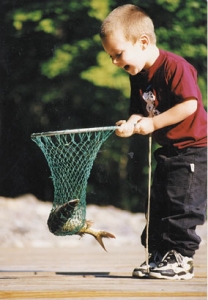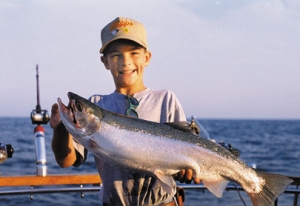by Jim Martinsen
Not all spinners are created equal. Spinners are assembled with many different parts. For spinners to function properly and to catch fish, those parts must work together flawlessly and they must do it day in and day out, cast after cast.
Face it, a fishing lure is a tool, much like a knife or an electric drill. Okay, maybe a spinner isn't as complex as a power tool, but if you're going to wind up with a tool to get the job done, the same attention to quality components apply to both.
Every Mepps spinner is hand-made. That's right. Every Mepps lure is hand assembled in our plant in Antigo, WI. Come visit us.
 The people who build our spinners are very important to us. After all, we make more than 5,000 different lures. Think about that for a minute. Five thousand lures times an average of six parts per lure. Now multiply that by the millions of lures Mepps fishermen gobble up every year, and you wind up with. . . well, a pretty staggering number to say the least.
The people who build our spinners are very important to us. After all, we make more than 5,000 different lures. Think about that for a minute. Five thousand lures times an average of six parts per lure. Now multiply that by the millions of lures Mepps fishermen gobble up every year, and you wind up with. . . well, a pretty staggering number to say the least.
Now consider that every one of those parts is specifically engineered and balanced for a specific lure. When a person gets ready to "build" a new Mepps spinner, all the correct components must be gathered up and assembled in the proper order, making sure at all times, that every component is perfect.
Let's see now, that would start with the hook and the strike attractor sleeve, or the hook dressing, whether it be natural hackle, squirrel or deer tail. Then there is the spinner shaft or wire, any beads, the body, a bearing bead if it is called for, the clevis and the blade. Whew!
Once assembled, the person who made the spinner is responsible for determining whether or not that spinner earns the Mepps name. Everything must be perfect. No one questions this decision. After all, who is better qualified to determine the fitness of a product than the person who built it from the ground up? No one.
This is important to us because it is so important to you. Three generations of fishermen have depended on Mepps spinners. Life has enough problems. More than anything else, fishing should be fun and relaxing. When your spinner drops into that hole behind the rock, following your perfect cast, you shouldn't have to worry whether or not the blade will begin spinning on the retrieve.
Mepps fishermen don’t have to worry about this because the shaft (wire) on a Mepps spinner and the clevis (that little saddle that attaches the blade to the shaft) are made from compatible metals. Because they are, the clevis becomes self-lubricating in the water so the blade flutters gently down and begins spinning with the first crank of the reel handle.
Speaking of the shaft and the clevis, it might interest you to know that the shaft, the backbone of a Mepps spinner, is made from Swedish Sandvic® stainless steel. This is the same steel used in the finest hand saws. Why? Because a spinner is a tool.
Take a close look at the clevis and you'll notice it is folded. Take a close look at other spinners and you'll probably discover the clevis is a piece of wire that's folded into a C and flattened on each end. You can take that C and easily pinch it flat. What do you suppose happens when that clevis gets caught between a couple of rocks, even small rocks that roll to the side when you pull to free the lure? We already know the answer to that, and we think you do too.
Now let's take a look at the bead on a Mepps spinner. On some spinners it is metal, solid brass to be precise; on others it is plastic. It might not surprise you much to learn that all of those metal beads are turned on a lathe. It might surprise you, however, to learn every plastic bead on a Mepps spinner is also turned on a lathe.
"Come on now," you might interject, "isn't that overkill? After all, a plastic bead is a plastic bead. They are molded by the millions. Why would Mepps have to turn their plastic beads on a lathe?"
 The answer is simple. Plastic molded beads break, and they break quite easily. Toss a spinner with a molded bead against a rocky wall where trophy walleye hang out and you've got yourself a spinner with a broken bead. Toss a Mepps Black Fury (page 6) against that same wall. . . no problem.
The answer is simple. Plastic molded beads break, and they break quite easily. Toss a spinner with a molded bead against a rocky wall where trophy walleye hang out and you've got yourself a spinner with a broken bead. Toss a Mepps Black Fury (page 6) against that same wall. . . no problem.
Mepps spinners feature the finest French hooks, and, as mentioned earlier, dressed hooks feature top quality natural dressings; some may be highlighted with products like Flashabou® for added attraction. But, again only top quality components are used. Mepps spinner bodies are solid brass, and again they are all hand-turned on a lathe.
If the shaft is the backbone of a spinner, the blade is the heart. After all, it's the blade that produces the flash and vibration that attracts fish. To say there is a tremendous amount of attention that is paid to the design, engineering and finish of a Mepps spinner blade would almost be an understatement. Blade thickness is controlled to the thousandths of an inch. Weight is controlled to the gram. (A gram is 0.03527396195 of an ounce). You think we don't sweat the details here at Mepps? Think again!
To begin with, all Mepps blades are solid brass. Mepps silver blades are plated with genuine silver, then lacquer coated to resist tarnishing. Why? Because silver reflects white. . . bright white. Chrome plated blades reflect black, so silver plated blades can be seen much easier underwater. Some brass blades, like the gold blade on the Mepps XD ( page 11) are 14 karat gold plated, again for flash. Painted finishes require special attention to detail. It can take years to develop a paint to withstand the rigors of day-to-day fishing. Remember, you're painting metal and then you're dragging it across sand, gravel, rocks and who knows what else. This is why Mepps blades are painted with computer age epoxy finishes that resist chipping, fading and cracking.
Mepps highly-reflective platium (pronounced play-tee-um) is the best metallic finish you'll find anywhere. Its bright flash is especially effective, attracting salmon as they gather at the mouth of streams to spawn. Successful salmon fishermen from the Great Lakes to Alaska are discovering the virtues of Mepps platium finishes. All this, and we haven't even begun to tell you of things like blade thump and dynamic balance. But none of this matters if you don't catch fish, and catching fish is what Mepps lures are all about. Three generations of Mepps fishermen can't be wrong. More record fish have been caught on Mepps than any other lure, and more than all other spinners combined. What more can be said. Other than. . . Mepps, World's #1 Lure.